
|

|
|
Home Site Search Contact Us Subscribe
|
|
|
Book Review: A Shout Out for Leers Weinzapfel Associates: "Made to Measure" - Some Meditations on Rejuvenating Campus Architecture By Norman Weinstein June 24, 2011 “Lovers of the Difficult” was one of many compellingly memorable phrases by the great poet Rainer Maria Rilke, and it’s a phrase that comes readily to mind when perusing the new retrospective monograph, Made to Measure: The Architecture of Leers Weinzapfel Associates (Princeton Architectural Press, 2011). Rilke intended the phrase to describe how great artists relish daunting aesthetic challenges. Oddly, the phrase seems descriptive of two directions in architecture today. One direction glories in how the newest technologically-driven engineering advances and novel materials can materialize any architectural forms anywhere on earth. So why not do so? Context and clarity of civic purpose be damned. The other direction, while embracing the design possibilities made possible by new technologies, finds deepest meaning in design driven largely by a sense of civic responsibility, making the fit between public and private enduringly beautiful. Perhaps we’re living in an era where some assume “if a radically new form of architecture can be built, let’s build it” – while some begin with “how can new architecture re-define and imaginatively re-formulate the traditional functional (and ethical) qualities inherent in long established architectural forms?” This goes beyond timid neo-traditionalism or vague rhetoric about context, and approaches architectural challenge as a synthesis of social geography, urban sociology, historical investigation, and innovative spatial problem-solving that thicken an intellectual weave. The practice of Leers Weinzapfel Associates fits this description to a T. Here’s how.
This book’s quarter-century overview of the firm’s work is grouped under three headings: “Compacting & Wrapping,” “Weaving & Embedding,” and “Stitching & Fitting.” The headings evoke textiles and fashion. That link becomes clear as you look at the plans and photographs for 11 exemplary projects, nine of which were designed for school campuses.
As tradition-bound architects continue to design campus architecture that rigidly adheres to the long-outdated notion of a college campus as a Jeffersonian “academic village,” Leers Weinzapfel Associates welcomes the non-Jeffersonian realities of the modern campus. Jefferson’s academic village model wasn’t created to accommodate and harmonize multi-purpose student union buildings, recycling centers, and computing labs, let alone the varieties of pedestrian and motorized circulatory movements modern campuses display. Most dramatically, the modern campus often finds itself interfacing a deliriously fluid and blurry boundary with the sprawling city enclosing it, struggling to align its own infrastructure, purposes, and culture with that of the greater city.
Leers Weinzapfel Associates treats extraordinary site and infrastructural challenges as opportunities for both imaginative play of imagination, and as opportunities to architecturally spell out the mission of civic architecture. That is what makes the firm’s University of Pennsylvania Gateway Complex such a solid thrill to behold. Talk about loving the difficult! Working on a lozenge-shaped parcel at the edge of the campus, the firm designed a 60,000-square foot chiller plant that is simultaneously a glowingly translucent sculptural gateway to the university (which has long had painful boundary issues with the unglamorous city edges facing it), and an intelligently costumed site of critical infrastructure.
Equally remarkable is the firm’s renovation of the MIT School of Architecture and Planning that underscores transparency between studios and corridors, expanding studios across formerly double-loaded corridors, and bringing much needed washes of natural light into the building. Not only is enhanced natural lighting a reward of their innovation, but the renovation makes a dent, however modest, into the exaggerated presence of “endless corridors” that has long plagued MIT’s classroom buildings.
Also admirable has been the firm’s design for the Smith College Fitness Center. With the college offering the firm the possibility of designing a high-profile, free-standing gym within walking distance of two existing gyms, one a 1920s Neo-Classical affair and the other a modern 1970s building, the firm chose to craft a new fitness center as a transparent structure spanning the two existing gyms. This difficult choice entailed carefully threading steel columns through the 1920s gym structure, and aesthetically finding a way that the new structure would aesthetically blend the surfaces and colors of 1920s brick and 1970s concrete. A free-standing fitness center would have been the easier design and engineering choice – but by choosing to conceptually bridge the distinguished college’s half-century in so carefully transparent a manner, their design visually underscores the school’s mission and spirit across generations.
The textile and fashion vocabulary of “wrapping,” “weaving,” and “stitching” suggest an architectural sensibility radically different than that which “thrusts” the newest skyscraper heavenward, or designs a new “intervention” (note the Imperialist resonance of the word) near Times Square. To weave architectural design entails a painstaking sensitivity to site and program, both of which are fluid. Particularly in the case of campus architecture, buildings become re-purposed or invented as faculty and student pathways, intellectual as well as walking paths that change with the seasons. It is to the enormous credit of Leers Weinzapfel Associates that they design with a weaver’s concern for an enduringly tight, glowingly cohesive design that lasts.
Norman Weinstein writes about architecture and design for Architectural Record, and is the author of “Words That Build” – an exclusive 21-part series published by ArchNewsNow.com – that focuses on the overlooked foundations of architecture: oral and written communication. He consults with architects and engineers interested in communicating more profitably; his webinars are available from ExecSense. He can be reached at nweinstein@q.com.
More by Weinstein:
A Meditation on the Beauty of Zaha Hadid's Door Handle Hadid's design issues a challenge: define beauty by lyrically playing with illusion.
Why "Greatest
Hits" Lists by Architecture's Stars Should Be Mocked
Celebratory Meditations on SANAA Winning the Pritzker Prize
Op-Ed: Life After Ada: Reassessing the Utility of
Architectural Criticism
Book Review: Diving
into Architecture from Every New Angle: Reading Guillevic's
"Geometries"
Book Review:
"Immaterial World: Transparency in Architecture": Marc Kristal
crystallizes increasingly complex notions of transparency with a light touch.
Book Review:
"Visual Planning and the Picuresque" by Nikolaus Pevsner. Edited by
Mathew Aitchison
Book Review: How New
Urbanism's Case Triumphs Best Through "The Language of Towns & Cities:
A Visual Dictionary" by Dhiru A. Thadani
Best Architecture
Books of 2010
Book
Review: "Architecture and Beauty: Conversations with Architects about a
Troubled Relationship": Yael Reisner exuberantly interviews architects
about beauty
Book Review: Shedding
Light on Concrete: Tadao Ando: Complete Works 1975-2010 by Philip Jodidio
Book Review: Sage
Architectural Reflections from Architecture's "Athena": Denise Scott
Brown's "Having Words" distills a lifetime of theorizing and practice
into practical and succinct guidance for thriving through difficult times
Book Review: Keeping
the Architectural Profession Professional: "Architecture from the Outside
In: Selected Essays by Robert Gutman" celebrates Gutman's legacy as
invaluable outsider
Book Review:
"Design through Dialogue: A Guide for Clients and Architects," by
Karen A. Franck and Teresa von Sommaruga Howard
Twilight Visions: Vintage Surrealist Photography Sheds
New Light on Architecture
Best
Architecture Books of 2009
Book Review: "Gunnar Birkerts: Metaphoric Modernist" by Sven Birkerts and Martin Schwartz A major architect in the history of Modernism finally receives recognition – and sundry asides about why Modernism never exited.
Book Review:
"Urban Design for an Urban Century: Placemaking for People," by Lance
Jay Brown, David Dixon, and Oliver Gillham
Book Review:
"Everything Must Move: 15 Years at Rice School of Architecture
1994-2009"
Book Review: A Subversive Book Every Architect Needs:
"Architect's Essentials of Negotiation" by Ava J. Abramowitz
Book Review: A Perspective from One Elevation: "Conversations With Frank Gehry" by Barbara Isenberg Gehry's conversations offer portraits of an astute listener as well as talker, an architect as aware of his flaws and limitations as of his virtues.
Best Architecture Books of 2008
Book Review: You've Got to Draw the Line Somewhere A review of Drafting Culture: a Social History of Architectural Graphic Standards by George Barnett Johnston
Book Review: "NeoHooDoo: Art for a Forgotten Faith," edited by Franklin Sirmans Sharpen your pencils - and get ready to do a NeoHooDoo shimmy.
|
(click on pictures to enlarge) 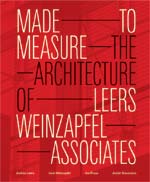
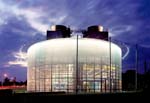 İPeter Aaron/Esto University of Pennsylvania Gateway Complex, Philadelphia, PA 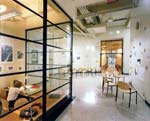 İChuck Choi MIT School of Architecture and Planning, Cambridge, MA 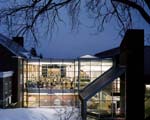 İAnton Grassl Smith College Fitness Center, Northampton, MA 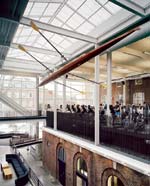 İAnton Grassl Smith College Fitness Center, Northampton, MA |
İ 2011 ArchNewsNow.com